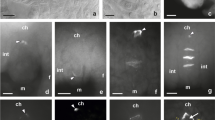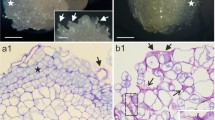Abstract
Cytochemical studies of androgenic anthers of Oryza sativa picked from the culture at 2 day intervals from 0 to 40 days have been carried out. Glutaradehyde-OsO4-fixed and plastic-embedded sections were stained with TBO, SBB and PAS for acidic polymers, lipids and polysaccharides respectively. Among the population only 4% of microspores, which accumulate abundant amorphous lipid in the first few days of culture, are androgenic. Less than 30%, which have many lipid granules and some amorphous lipid, become nutritive microspores. Starch grains also accumulate in these nutritive microspores which degenerate at the stage when the androgenic multicellular microspores are in rapid development. The remaining microspores, which have no or little lipid, degenerate early. At about the 100-cell stage, each multicellular unit consists of two cell types, large and small. The large cells contain abundant amorphous lipid and starch grains which the small ones stain intensely with TBO.
Our results indicate that the epidermis and endothecium of the cultured anthers are not quiescent. They can accumulate and transport lipid and polysaccharides at certain stages during the cultural period. Globular embryoid appearing structures and leaf-like protrusions can be observed at the surface of the callus in about 40-day old culture, indicating that both embryogenesis and organogenesis may take place in rice callus.
Similar content being viewed by others
Abbreviations
- OsO4 :
-
osmium tetroxide
- TBO:
-
toluidine blue O
- SBB:
-
sudan black B
- PAS:
-
periodic acid-Schiff's reagent
- NAA:
-
1-naphthaleneacetic acid
References
Bajaj YPS (1983) In: Evans, Sharp, Ammirato and Yamada (eds.), Handbook of Plant Cell Culture. Macmillan Pub. Co., New York. pp. 228–287.
Bourgin JP, Nitsch JP (1967) Ann. Physiol. Veg. 9:377–382.
Chao CY (1977) Amer. J. Bot. 64:921–930.
Chao CY (1979) Phytomorphology 29:381–387.
Chayer J, Bitensky L, Butcher RG (1973) Practical Histochemistry. Wiley, London.
Chen CC (1977) In Vitro 13:484–489.
Chen CC, Wu YH (1983) Proc. Natl. Sci. Counc. B., ROC 7:151–157.
Chen LJ, Lai PC, Liao CH, Tsay HS (1982) J. Agric. Res. China 31:283–290.
Chu CC, Wang CC, Sun CS, Chen H, Yin KC, Chu CY, Bi FY (1975) Sin Sinica 18:659–668.
Esau K (1977) John Wiley and Sons, New York.
Genovesi AD, Magill CW (1982) Plant Cell Report 1:257–260.
Guha S, Maheshwari SC (1964) Nature 204:497.
Guha-Makherjie S (1973) J. Exp. Bot. 24:139–144.
Iyer RD, Raina SK (1972) Planta 104:146–156.
Murashige T, Skoog F (1962) Physiol. Plant. 15:473–497.
Niizeki H, Oono K (1968) Proc. Jap. Acad. 44:554–557.
Pearse AGE (1968) Histochemistry, Theoretical and Applied. Vol. 1. J. and A. Churchill, Ltd., London.
Raghavan V (1976) Science 191:188–189.
Raghavan V (1979a) Amer. J. Bot. 66:36–39.
Raghaven V (1979b) Amer. J. Bot. 66:784–795.
Raghaven V (1981) J. Cell Biol. 89:593–606.
Sangwan-Norrell BS (1978) Can. J. Bot. 56:805–817.
Sunderland N, Collins GB, Dunwell JM (1974) Planta 117:227–241.
Sunderland N, Wicks FN (1971) J. Exp. Bot. 22:213–216.
Author information
Authors and Affiliations
Additional information
Communicated by J.M. Widholm
Rights and permissions
About this article
Cite this article
Tsay, S.S., Tsay, H.S. & Chao, C.Y. Cytochemical studies of callus development from microspore in cultured anther of rice. Plant Cell Reports 5, 119–123 (1986). https://doi.org/10.1007/BF00269249
Received:
Revised:
Issue Date:
DOI: https://doi.org/10.1007/BF00269249




